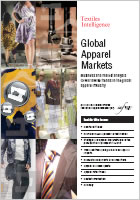Issue
10:
2nd Quarter 2010

Product Overview
Buy this Report now
Buy this Issue now
Subscribe
Download brochure (PDF)
Download price list (PDF)
Price list download
| Please choose your preferred currency:
|
Request sample issue
View list of reports
in other issues
|
Multi Report Package |
We also offer a flexible subscription product,
the Multi Report Package,
which allows you to select your own choice of reports from our full range,
to suit your own budget.
Click here for full details.
|
|
 |
Changing apparel sourcing strategies |

11 pages,
published in Issue 10, 2nd Quarter 2010
Report price:
Euro 395.00;
US$ 520.00
|
Over the past 18 months, companies have been focusing more intensively on the contribution of overseas sourcing offices and the relationships they have with their suppliers as they look for further ways to reduce costs and operate more efficiently.
Many retailers have responded to the need to deliver ?more for less? to consumers by shifting massively across different types of products (not just clothing), by sourcing heavily from China, and by establishing direct sourcing operations. However, this approach has under-optimised the value which changes in the sourcing model can provide. Consequently, leading retailers and brands have been developing their sourcing strategies in order to not only look at a balanced portfolio of markets but also change the ways in which they work with suppliers to develop and deliver products to market. As a result they are more aware of the total cost of bringing a product to market, as well as considerations relating to the market, supplier and product which dictate the product?s final price.
Regardless of the location from which retailers source, it will remain an imperative that more responsibility is placed upon the supporting overseas sourcing office and that strong relationships are developed with a few key strategic suppliers to provide opportunities for driving efficiencies throughout the process. In a post-recession period, businesses need to stay focused upon continuous improvement and operational excellence. As retailers? sales begin to improve, the tendency will be to fall back on old habits, but retailers must make sure this trap is avoided.
By putting into place a well defined strategic sourcing plan which addresses the entire cost of sourcing, retailers will redefine relationships with suppliers and revise their internal organisations, processes and behaviours in order to ensure that cost reduction remains a top priority for years to come.
- Changing sourcing models: from agents to overseas sourcing offices
-
- Summary
- Changing sourcing models: from agents to overseas sourcing offices
- Evaluating the performance and structure of the overseas sourcing office
- The growing role of the overseas sourcing office
- Embracing the expertise of overseas sourcing offices and suppliers
- Finding opportunities to create extra value
| Global Apparel Markets provides intelligence, analysis and insight on the global apparel industry. |  | What's in it?
Each issue contains: essential information on trade and trade policy; news from leading brands, companies and other organisations; analysis of key geographical markets; and expert opinions on strategy. A single issue of Global Apparel Markets includes:  practical and strategic advice from industry experts practical and strategic advice from industry experts  a report on a key geographical market a report on a key geographical market  a round-up of the latest product innovations a round-up of the latest product innovations  a feature on trade and trade policy a feature on trade and trade policy  comprehensive information on the latest business developments comprehensive information on the latest business developments
An annual subscription to Global Apparel Markets is a cost-effective way to keep informed about trends and developments in the global apparel industry. Subscriptions are available in printed and/or digital formats. Printed and digital subscribers receive each issue in printed format in addition to a digital PDF file, which is available immediately on publication. Subscribers also receive a complementary digital subscription to Global Apparel Update, delivered directly by email once a month. This free supplement contains essential information on business news and the latest product developments. Like all Textiles Intelligence publications, Global Apparel Markets is a reliable source of independently sourced business information, and it does not carry advertising.
| This is what our customers say: |
"In our work, we were looking for industry insights and trends - who the major suppliers were, which countries were producing and what, productivity rates, investment incentives, where investors were moving to and why, etc. A lot of the individual country case studies you did were great - I remember one recently on the UK for example. There was also a great article from a guy on the Turkish market and recent trends there. Both these articles were written for the layman so they were easy to understand but comprehensive at the same time.
The technology articles were also interesting.
Basically, it was an all-round good publication that covered everything in enough depth so that you would always find something of interest in each issue." |
| (Alan J. Saffery; Competitiveness, Private Sector & Economic Growth ; Saffery Consulting) |
|
|
 |
